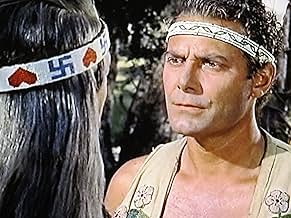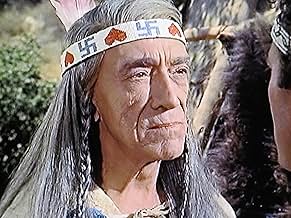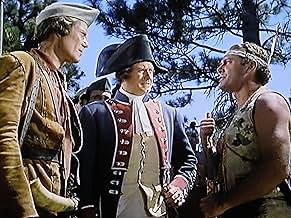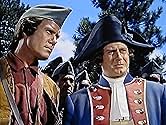In 1753, during the French and Indian War, Colonel George Washington and frontiersman Christopher Gist hope to persuade the Delaware tribes to join the British side but French spies aim for ... Read allIn 1753, during the French and Indian War, Colonel George Washington and frontiersman Christopher Gist hope to persuade the Delaware tribes to join the British side but French spies aim for a contrary outcome.In 1753, during the French and Indian War, Colonel George Washington and frontiersman Christopher Gist hope to persuade the Delaware tribes to join the British side but French spies aim for a contrary outcome.
Abdullah Abbas
- Soldier
- (uncredited)
Jessie Arnold
- Gossip at Wrestling Match
- (uncredited)
Ray Beltram
- Indian
- (uncredited)
George Bruggeman
- Wrestling Match Spectator
- (uncredited)
Jack Chefe
- French Lieutenant
- (uncredited)
Jerado Decordovier
- Soldier
- (uncredited)
Gregory Gaye
- St. Pierre
- (uncredited)
Al Haskell
- Soldier
- (uncredited)
- Director
- Writer
- All cast & crew
- Production, box office & more at IMDbPro
Featured reviews
From the prolific pen of screenwriter Robert E. Kent comes this colourful historical fantasy about George Washington's early days as a loyal British soldier. He's played stolidly by James Seay, who does his best under the circumstances. Washington is trying to forge an alliance with the Delaware Indian tribe against the French, who have lined up their own set of Native American militia in an effort to assert their authority over the Atlantic Seaboard. The aging Jon Hall, an expert at playing 'non-white' characters in earlier films such as The Hurricane (1937) and Arabian Nights (1942), is appallingly miscast as Prince Hannoc, the heir to the Delaware throne and a vital pawn in the British plans. When his arranged marriage to Indian maiden Morna (Sherry Moreland) falls through, Hannoc's father Shingis (Pedro de Cordoba, who gets the film's best lines and delivers the best acting) declares his neutrality, setting in motion the reasonably well realized action sequences that dominate the final half hour of the film. Produced by cheapskate producer Sam Katzman, When the Redskins Rode is ostensibly shot in SuperCineColor, which actually seems to consist of two distinctly different types of film stock. Most of the film is bright and sharp, but there are frequent scenes shot on what seems to be washed out film stock. Thanks to the wonders of SuperCineColor and the inability of DoP Lester White to adapt the lighting accordingly, the film also suffers from some of the worst day-for-night cinematography you'll ever see. Basically, scenes at night appear to have been shot in broad daylight with a few crickets overdubbed to add suitable night time ambiance.
'When the Redskins Rode' seems intended as a follow up to Sam Katzman's earlier Columbia release 'Last of the Redmen' (1947), which had also been set in the 1750s, starred Jon Hall and employed an exotic new colour process to detail a trek across what appears to be the same distinctive Californian terrain (the earlier film was the only feature ever made in a process called Vitacolor; while 'When the Redskins Rode' is in SuperCinecolor. It looks very attractive for the most part but - as the two previous writers have both already observed - produces distinctly blurry and inconsistent results in some of the location scenes).
Set in 1753, the plot resembles many Japanese samurai films I've sat through in which high-level intrigue between rival shogunates is discussed at great and passionate length, punctuated with occasional pauses for a bit of large scale violent action. The two rival powers are here the British and the French; the former commanding the loyalty of American-Indian hero Jon Hall and 'Colonel' Washington, played by James Seay. The 18th century French uniforms occasionally used for target practice provide visual novelty, while Mary Castle and John Dehner as a pair of French spies and Gregory Gaye as Captain Saint-Pierre of Fort LeBoeuf are sneering villains worthy of an old war movie. (Considering how soon after the end of World War II this was made, it's rather startling to see the late Pedro de Cordoba as Chief Shingiss wearing a headband decorated with swastikas and upside-down hearts; while one of the goons sent to kill him blurts out that they were only following orders).
Set in 1753, the plot resembles many Japanese samurai films I've sat through in which high-level intrigue between rival shogunates is discussed at great and passionate length, punctuated with occasional pauses for a bit of large scale violent action. The two rival powers are here the British and the French; the former commanding the loyalty of American-Indian hero Jon Hall and 'Colonel' Washington, played by James Seay. The 18th century French uniforms occasionally used for target practice provide visual novelty, while Mary Castle and John Dehner as a pair of French spies and Gregory Gaye as Captain Saint-Pierre of Fort LeBoeuf are sneering villains worthy of an old war movie. (Considering how soon after the end of World War II this was made, it's rather startling to see the late Pedro de Cordoba as Chief Shingiss wearing a headband decorated with swastikas and upside-down hearts; while one of the goons sent to kill him blurts out that they were only following orders).
Westerns of the mid-18th century are uncommon, and the plot for WTRR is interesting enough: English/American colonists versus the French, both sides aided by different Native American tribes. (Of course therse are features of other Westerns of this period). Colourful camera-work and some good action towards the end, but the main characters are unconvincing, especially Jon Hall, looking every one of his 37 years and nothing like a Native American. (And "Prince" ??? Hannoc???) Sherry Moreland was almost as unbelievable as Morna, especially with the way her hair was arranged in her bath-tub scene. And Mary Castle's dresses were far too extravagant for someone on a long-term stay in a rowdy tavern - though, admittedly, her room there was very well appointed.
One point of interest was the suggestiveness early on the film when Elizabeth invited Prince Hannoc to visit her in her room - almost too suggestive for an early 1950s film. And I can endorse the plaudits already expressed for Pedro de Cordoba as Chief Shingiss - he stole many of the scenes in which he featured.
Many of the supporting cast did well enough, and it's always rewarding to see John Dehner (here almost unrecognisable in a period wig).
One point of interest was the suggestiveness early on the film when Elizabeth invited Prince Hannoc to visit her in her room - almost too suggestive for an early 1950s film. And I can endorse the plaudits already expressed for Pedro de Cordoba as Chief Shingiss - he stole many of the scenes in which he featured.
Many of the supporting cast did well enough, and it's always rewarding to see John Dehner (here almost unrecognisable in a period wig).
¨When the Redskins Rode¨ is an ordinary and tolerable Indian Western , a run-of-the-mill yarn with usual confrontation between French troopers and Britsh army with Indian tribes supporting both sides . By the time of the conflict, the boundaries between British and French colonial possessions in America were not well defined. The Seven Years' War broke out between 1754 and 1755 when the British attacked French-claimed positions in North America and captured a significant number of French merchant ships. However, the large-scale conflict that mobilized most of the European powers centered on the Austrian ambition to regain Silesia, lost to Prussia during the War of the Austrian Succession. The Seven Years' War was characterized in Europe by the siege and burning of towns, as well as by battles in the open with the massive loss of human lives. The conflict was a historic milestone whose devastating economic consequences on the European powers would eventually trigger the American Revolution in 1765, the French Revolution in 1789, the Haitian Revolution in 1791, as well as the rest of the revolutions and insurrections that culminated in the process. Of decolonization of the American continent in the XIX century. The film is set in 1753, Col. George Washington (James Seay) and frontiersman Christopher Gist (John Ridgely) are proudly introducing their protégé, Delaware Indian Prince Hannoc (John Hall) to Williamsburg, Virginia society. French spy Elizabeth Leeds (Mary Castle ) and her lover (John Dehner) plot a scheme against Hannoc (John Hall) , hoping to swing the Delawares to the French side in the impending colonial war. Things go wrong when Hannoc's father, Chief Delaware Shingiss (Pedro de Cordoba) comes to Williamsburg to sign a mutual defense pact with the British ruled by King George III that are allied along with the Mohicans , while the Wyandat and Huron tribes support the French army under kingdom Louis XV . Our protagonists must pass through a dangerous territory surrounded by hostile enemies until Fort Boeuf . Along the way, Hannoc falls in love for two beauties , the traitor Elizabeth Leeds (Mary Castle) and Indian maiden Morna (Sherry Moreland) and with Washington and his troops besieged at Fort Necessity. Untold Excitement and Tumultous Adventures...on the warpath in SUPERcineCOLOR!
The film packs thrills , fights , noisy action , crossfire , Indian charges , including natives habits with their rites and ceremonies and being entertaining enough .Moving and action-packed Western with a simple , standard story that engages the viewer until the last scene at Fort Necessity when Indians comes to the rescue . It's a medium-short budget film with comfortable actors , technicians , functional production values and passable results . Being freely based on historical events . Stars the handsome John Hall as the Indian chief Hannoc who saves Washington and his men from a French trap during a peace mission while unmasking a spy just as war breaks out . And appearance by some legendary roles as George Washington himself well played by James Seay and Delaware chief played by Pedro de Cordoba .
It contains an atmospheric and adequate musical score , as well as faded and tarnished cinematography by Lester White with a very bad print , being utterly necessary a perfect remastering . Produced in low budget by Sam Katzman , due to a combination of intelligent marketing and the fact that he ground out films so quickly and cheaply that he could cash in on a fad before it faded away, Katzman's movies seldom if ever lost money , and taking a lot of stock-footage here and there . At first he started producing action/adventure serials , where he got the nickname "Jungle Sam" , Katzman's output encompassed virtually every genre imaginable. In the 1930s he turned out Tim McCoy westerns for Puritan and Victory, the next decade he was grinding out the East Side Kids series at Monogram, the 1950s saw him making sci-fi opuses and teenage musicals for Columbia and in the 1960s he was cranking out hippie/biker films for AIP and Elvis Presley musicals for MGM. The motion picture was professionally directed by Lew Landers , rivaling Sam Newfield and William Beaudine as one of the American film industry's most prolific directors, The Raven was his first feature made under his real name . Landers galloped his way around 130 films , called quickfire and almost none of them exceeding 80 minutes , they have nearly all vanished into the mists of time now, exception for his cult movie : The Raven (1935)
The film packs thrills , fights , noisy action , crossfire , Indian charges , including natives habits with their rites and ceremonies and being entertaining enough .Moving and action-packed Western with a simple , standard story that engages the viewer until the last scene at Fort Necessity when Indians comes to the rescue . It's a medium-short budget film with comfortable actors , technicians , functional production values and passable results . Being freely based on historical events . Stars the handsome John Hall as the Indian chief Hannoc who saves Washington and his men from a French trap during a peace mission while unmasking a spy just as war breaks out . And appearance by some legendary roles as George Washington himself well played by James Seay and Delaware chief played by Pedro de Cordoba .
It contains an atmospheric and adequate musical score , as well as faded and tarnished cinematography by Lester White with a very bad print , being utterly necessary a perfect remastering . Produced in low budget by Sam Katzman , due to a combination of intelligent marketing and the fact that he ground out films so quickly and cheaply that he could cash in on a fad before it faded away, Katzman's movies seldom if ever lost money , and taking a lot of stock-footage here and there . At first he started producing action/adventure serials , where he got the nickname "Jungle Sam" , Katzman's output encompassed virtually every genre imaginable. In the 1930s he turned out Tim McCoy westerns for Puritan and Victory, the next decade he was grinding out the East Side Kids series at Monogram, the 1950s saw him making sci-fi opuses and teenage musicals for Columbia and in the 1960s he was cranking out hippie/biker films for AIP and Elvis Presley musicals for MGM. The motion picture was professionally directed by Lew Landers , rivaling Sam Newfield and William Beaudine as one of the American film industry's most prolific directors, The Raven was his first feature made under his real name . Landers galloped his way around 130 films , called quickfire and almost none of them exceeding 80 minutes , they have nearly all vanished into the mists of time now, exception for his cult movie : The Raven (1935)
When Columbia released this Sam Katzman production Where The Redskins Rode in 1951 already folks were offended. By 1971 no one would have dared release a film with that title, let alone this day and age.
Wouldst the title be the only thing wrong with this film. This is a story of romance in the Delaware Indians between the chief's son Jon Hall and princess Sherry Moreland. It's a rough rocky romance because there's a sly Mata Hari in the mix, a mixed race woman played by Mary Castle who lives above a tavern where no decent woman would and she's also a spy for the French.
This little triangle is against the background of the Battle for Fort Necessity in which young Virginia planter named George Washington and his frontier guide Christopher Gist set and then lost to the French. This minor skirmish in America set off the global conflict known as the Seven Years War with battles between the British and French fought literally around the world. George Washington is played by James Seay and Gist by John Ridgely.
To keep your Indian tribes straight the Delawares, Jon Hall's good Indians dressed like plains Indians and the French supporting Indians supported Mohawk haircuts as was their fashion. Hall's Indians also rode horses in fact he leads a cavalry charge in the climax. As this was a Sam Katzman production nothing in the budget went into research.
When The Redskins Rode is offensive on so many levels, skip this one by folks.
Wouldst the title be the only thing wrong with this film. This is a story of romance in the Delaware Indians between the chief's son Jon Hall and princess Sherry Moreland. It's a rough rocky romance because there's a sly Mata Hari in the mix, a mixed race woman played by Mary Castle who lives above a tavern where no decent woman would and she's also a spy for the French.
This little triangle is against the background of the Battle for Fort Necessity in which young Virginia planter named George Washington and his frontier guide Christopher Gist set and then lost to the French. This minor skirmish in America set off the global conflict known as the Seven Years War with battles between the British and French fought literally around the world. George Washington is played by James Seay and Gist by John Ridgely.
To keep your Indian tribes straight the Delawares, Jon Hall's good Indians dressed like plains Indians and the French supporting Indians supported Mohawk haircuts as was their fashion. Hall's Indians also rode horses in fact he leads a cavalry charge in the climax. As this was a Sam Katzman production nothing in the budget went into research.
When The Redskins Rode is offensive on so many levels, skip this one by folks.
Did you know
- TriviaUses footage from Northwest Passage (1940).
Details
- Runtime1 hour 18 minutes
- Aspect ratio
- 1.37 : 1
Contribute to this page
Suggest an edit or add missing content

Top Gap
By what name was When the Redskins Rode (1951) officially released in India in English?
Answer



















